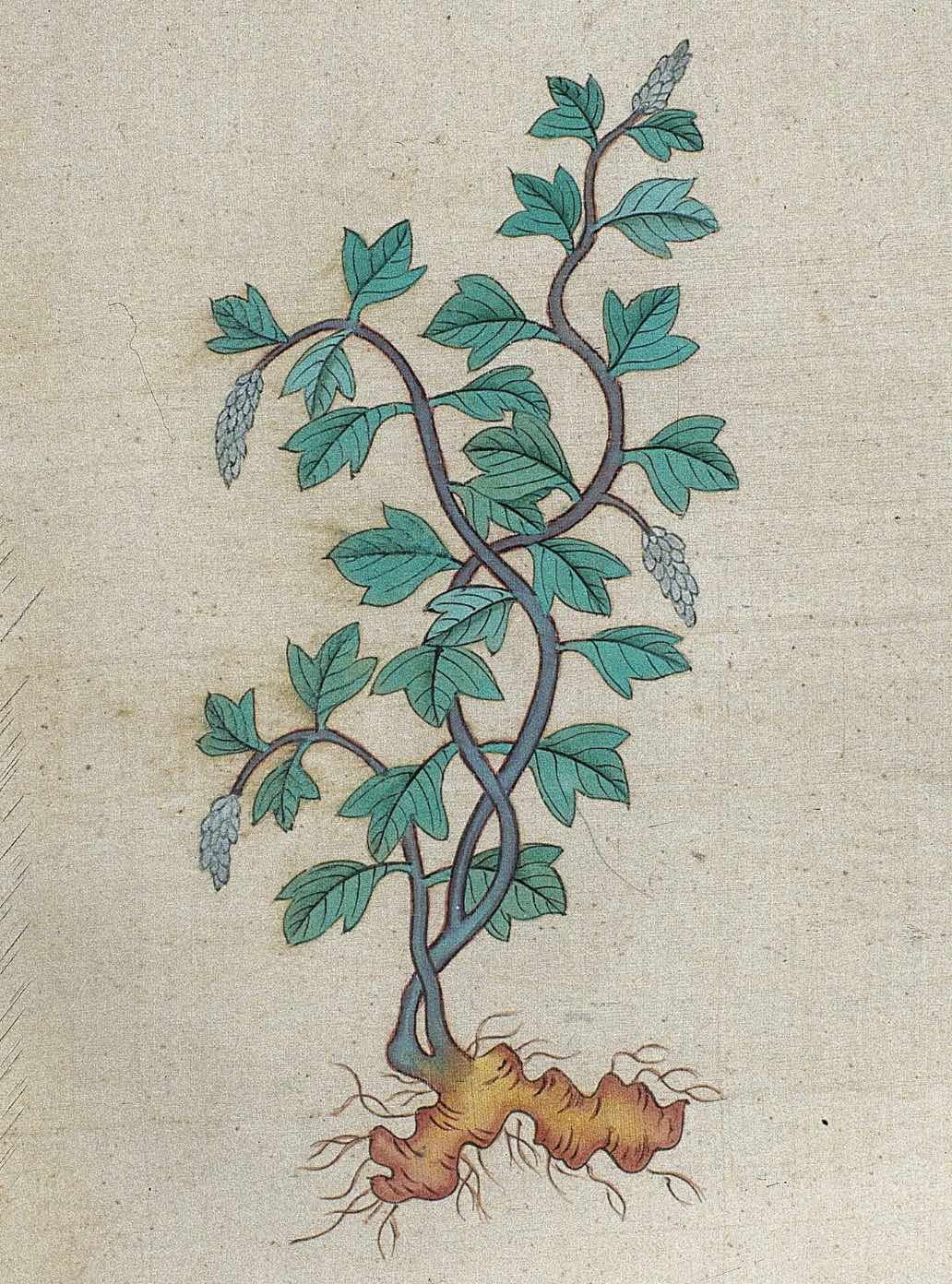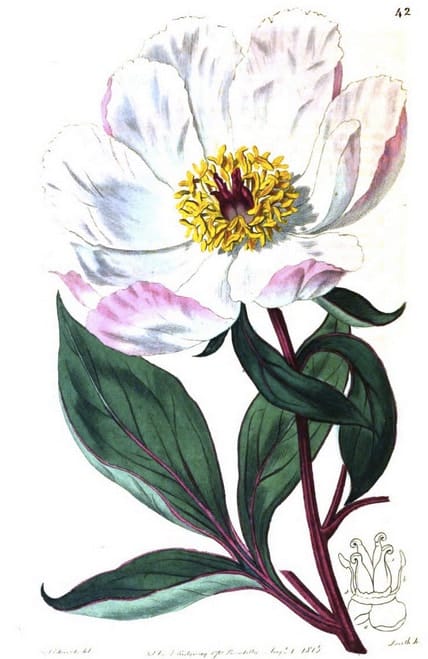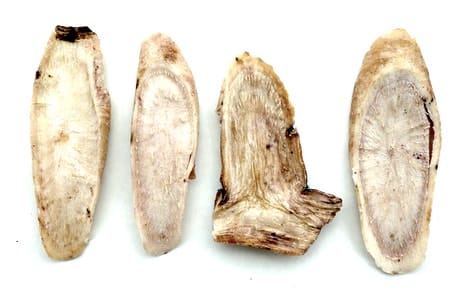Paeonia lactiflora, Chinese Peony, Shao Yao 芍药White Peony, Bai Shao 白芍Red Peony, Chi Shao 赤芍 |

|
 Chinese Peony (Ming Herbal (Welcome)
Chinese Peony (Ming Herbal (Welcome) P. lactiflora
P. lactifloraThe Botanical Register, Edwards & Lindley, 1815
 Slices of wild, unsulphured White Peony Bai Shao (Adam, Chengdu Medicine Market, 2017)
Slices of wild, unsulphured White Peony Bai Shao (Adam, Chengdu Medicine Market, 2017)Botanical name:
TCM uses 2 types of herbaceous Peony, designated ‘Red’ and ‘White’ (based on the color of their root):
- White: Bai Shao Yao: Paeonia lactiflora, P. albiflora
- Red: Chi Shao Yao: P. lactiflora, P. veitchii, P. obvata
- P. officinalis (Western Peony)
- Tree Peony Mu Dan Pi. (Tree Peony)
Parts used:
Root
Temperature & Taste:
Cool, neutral in respect of dryness. Bitter, Sour.
The Red Peony is colder.
Classification:
White: N. Blood Tonic
Red: B. Clears Heat, Cools the Blood
Uses:
WHITE CHINESE:
1. Nourishes the Blood:
-signs of deficient blood, including pale face and tongue, fatigue, dizziness, headache
-menstrual dysfunction, uterine bleeding, leukorrhea.
-‘good for treating all sorts of feminine diseases including ante- and postpartum diseases’. (Da Ming)
-‘Improves Eyesight’ (Da Ming)
2. Calms and Soothes the Liver, Eases pain:
-a wide range of Liver disorders with symptoms such as pain in the chest, flank or abdomen, and also headaches, dizziness, irritability etc from Liver dysfunction.
-Spasms in the abdomen and cramps of the extremities.
-Wind disorders associated with Yin or Blood deficiency
-very important herb for a wide range of Liver disorders in TCM.
3. Restrains and Consolidates the Yin and Body fluids:
-leukorrhea, spermatorrhea.
-various types of sweating from deficiency, including Yin deficient night sweats, and spontaneous sweating
-Hectic Fever from Yin deficiency (Zhen Quan)
4. Benefits Spleen, Increases Qi:
-‘reinforces Qi’. (Shen Nong Ben Cao, Da Ming)
-treats Spleen deficiency. (Wang Haogu)
-‘reinforces the Five Viscera and tones the Kidney’. (Zhen Quan)
RED CHINESE:
1. Moves the Blood, Clears Blood Stasis:
-amenorrhea, dysmenorrhea
–abdominal pain
-headaches with fixed pain.
-various types of injury due to internal or external trauma to help ease the swelling and pain. (stir-fried in wine is best)
2. Clears Heat, Cools the Blood:
-when heat enters the blood during fevers, manifesting as purple blotches on the skin, red skin rashes etc.
-bleeding from strong heat in the blood.
-In TCM, Red Peony is often added to formulas where strong blood cooling medicines are used to prevent the blood stasis that can accompany such treatment.
3. Clears Liver Heat:
-red, swollen and painful eyes from Liver heat.
Dose:
Red and White Peony root can be used in the same doses.
Decoction: 3–9 grams
Powder: 1–3 grams
Comment:
1. The European Peony and Chinese White Peony are almost analogous with the European being better to stop Wind and settles Spasms, the Chinese White Peony being more tonifying to the Blood and Yin. The Chinese Red Peony is Colder, less tonifying, and better to move the Blood and clear Heat from the Blood and Liver.
2. Red Peony is better for clearing Blood heat and is slightly purgative, the White Peony nourishes Blood and Liver.
3. Red Peony can replace White Peony in a formula if there is Blood Heat or Blood stasis. White Peony is used when a stronger Blood and Liver Yin tonic is required.
Corrective:
1. Licorice
2. In summer, take with Scutellaria Huang Qin
Preparation:
1. Wine-fried Peony Shao Yao:
Slices of Peony root are sprinkled with wine, then stir-fried until dry and slightly yellowed. This reduces its cooling nature and makes it slightly warm while being better to activate the blood. Li Shi Zhen said it also nourishes Yin.
2. Vinegar-fried Peony Shao Yao:
The sliced root is prepared as above, using vinegar in place of wine. This was prepared by some for women’s diseases.
3. Steamed Peony root:
The sliced root is steeped in Honey and water, then steamed. This increases its nourishing, strengthening nature and makes it slightly warm and sweet.
4. Stir-fried with Licorice:
According to Li Shi Zhen, when stir-fried with Licorice root, it relieves abdominal pain.
Main Combinations:
Peony & Licorice
WHITE CHINESE PEONY:
1. To Nourish the Liver and Blood:
i. Paeonia Bai Shao is combined with Dang Gui to nourish the Blood and regulate menstruation
ii. to nourish the Blood, Paeonia Bai Shao with Rehmannia Shu Di Huang and Ligustrum Chuan Xiong (as in Si Wu Tang)
2. To strengthen the Spleen, Paeonia Bai Shao with Atractylodes Bai Zhu
3. Menstrual cramping and pain Paeonia Bai Shao with Cyperus rotundus (Xiang Fu)
4. Heat of the Uterus, Paeonia, Soloman’s Seal, Tribulus as a decoction. (Tibetan Medicine)
5. To help expel Measles, Paeonia Bai Shao with Saposhnikovia Fang Feng (Li Shi Zhen)
6. To warm, the channels and expel humidity, Paeonia Bai Shao with fresh Ginger and Chinese Red Dates. (Li Shi Zhen)
7. Spontaneous Sweating, Paeonia Bai Shao with Astragalus Huang Qi.
8. Weakness after Childbirth Paeonia Bai Shao with Cinnamon and Licorice (as in Shao Yao Tang from Sheng Ji Zhong Lu [The Complete Record of Holy Benevolence])
9. Abdominal pain and cramping; weakness and spasms of the lower limbs, and headaches due to Blood deficiency, Paeonia Bai Shao with Licorice
10. To soothe the Liver, move Qi, for abdominal pain and cramping, Paeonia Bai Shao with Dang Gui, Cyperus rotundus, Peppermint, Licorice
11. Dysentery:
i. Paeonia Bai Shao with Coptis Huang Lian (Li Shi Zhen)
ii. with Blood, Paeonia Bai Shao with Dang Gui, Coptis Huang Lian, Areca Bing Lang (Betel Nut), Costus Mu Xiang, Licorice (Gan Cao), Rhubarb root (Da Huang), Scutellaria Huang Qin, Cinnamon bark (Gui Pi) (as in Shao Yao Tang, from Su Wen Bing Ji Bao Ming Ji)
12. Health Tonic to nourish Qi and Blood, Paeonia Bai Shao (5 parts) with Astragalus Huang Qi (2 parts), Ligusticum Chuan Xiong, Dang Gui, Rehmannia Shu Di Huang, Cinnamon, Licorice, Ginger, Chinese Dates (Da Zao) (1 part each). This is reputed to be the favorite tea of Huang Di (the Yellow Emperor). It nourishes Qi and Blood, treats exhuastion and convalescence.
RED CHINESE PEONY:
1. Menstrual pain and clotting from Qi and Blood stasis, Paeonia Chi Shao, Dang Gui, Ligusticum Chuan Xiong
2. For stronger Blood stasis add Peach kernel (Tao Ren) and Safflower (Hong Hua) to the above
3. Hypochondriac or abdominal pain, Paeonia Chi Shao, with Cyperus rotundus Xiang Fu
4. Bruising and Trauma, Paeonia Chi Shao, with Myrrh and Frankincense
5. Liver Heat, Paeonia Chi Shao, with Scutellaria Huang Qin
Major Formulas
Bai Zhu Shao Yao San
Bu Gan Tang
Chai Hu Shu Gan San
Dang Gui Shao Yan San
Dang Gui Yin Zi
Ding Jing Tang
Fu Zi Tang
Gui Zhi Fu Ling Wan
Gui Zhi Fu Zi Tang
Gui Zhi Tang
Hei Xiao Yao San
Hu Po San
Huang Lian E Jiao Tang
Ren Shen Yang Rong Tang
Shao Yao Gan Cao Tang
Si Ni San
Si Wu Tang
Tai Shan Pan Shi San
Tong Qiao Huo Xue Tang
Xiao Qing Long Tang
Xiao Yao San
Zhen Wu Tang
Cautions:
WHITE CHINESE: not used for Cold Stomach and Spleen
RED CHINESE: not used for anemia from deficiency (weak Blood)
Main Preparations used:
Distilled Water of the Roots and Flowers, Syrup of the Infusion of the Flowers, Extract of the dried Flowers, Conserve of the Flowers, Salt of the Ashes
